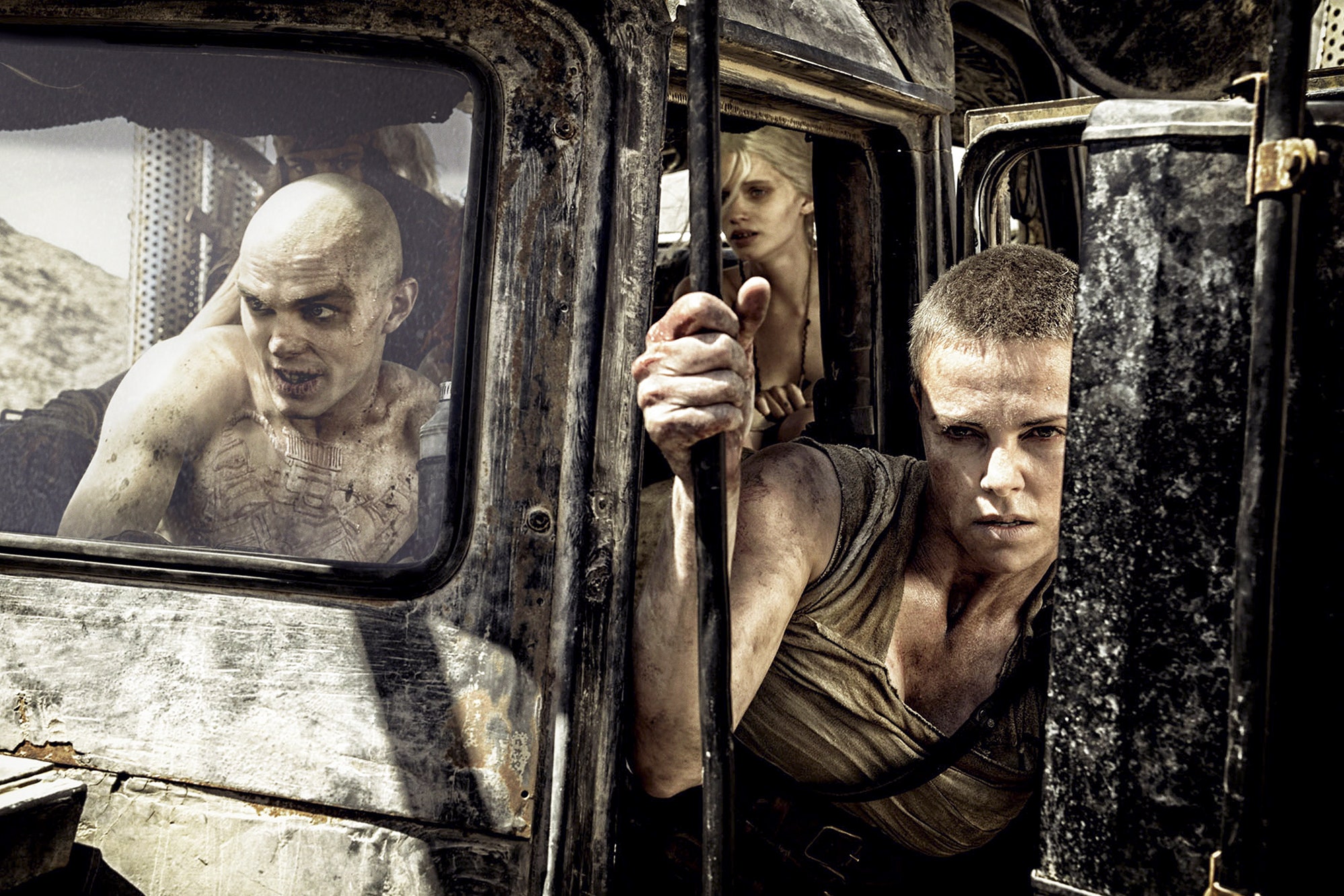The most imaginative and directorially accomplished movie of the year, Mad Max: Fury Road is a hell of a vision from director George Miller, 70 and at the peak of his powers, upending the action genre by delivering an antithetical, feminist war cry that takes off like a shot and sustains its frenzied mania for two hours. That might be good, or not so good, depending upon your perspective, and this is a massive, loud, propulsive juggernaut of a movie, visually ingenious in ways that are nearly impossible to describe, and one that demands sustained audience engagement.
It’s been thirty-six years since 1979’s scrappy Mad Max, which thrust star Mel Gibson into stardom as an ex-cop on a death wish manhunt for the wasteland marauders who killed his wife and child. Miller made good on that picture’s promise with 1982’s The Road Warrior, a chase extravaganza widely considered the pinnacle of the series (and closest cousin to the new picture). For my money, 1985’s Mad Max: Beyond Thunderdome was the apex, a perfect amalgam of theme, poetry and action, at least one of which is missing in Mad Max: Fury Road, which fires on all cylinders but leaves Max himself somewhat in the fumes.
And that’s not a criticism, per se, because this novel, exhilarating and most importantly, estrogen-fueled chase movie, complete with dizzyingly luscious Namibian (doubling for the Outback) cinematography, jaw-dropping stunts (largely free of CGI), gonzo set pieces and a dynamic performance from star Charlize Theron redefines what an action film can and should be. And while its sustained pace and increasingly over-the-top sequences are very much in the wheelhouse of a contemporary action film—Miller knows today’s audience well—it might have benefited from a larger dose of substance.
The hotly anticipated sequel posits a simple story—a band of women escape an oppressive dictator and are pursued across the post-apocalypse—whipping it up into epic proportions (think The Road Warrior on steroids) and commenting on such contemporary themes as radicalized, blindly-devoted zealots and the subjugation of women and exploitation of their bodies.
Mad Max: Fury Road opens with Max Rockatansky in decidedly dire straits, taken captive by the henchman of a mad desert dictator named Immortan Joe (The Road Warrior’s Hugh Keays-Byrne), who rules a ragtag kingdom of slaves from a cliffside throne, keeping Max alive for his blood while parsing precious water to the downtrodden below. Meanwhile, he harvests breast milk from his pregnant concubines into some sort of mad cocktail for his favorite subjects.
Max fails to escape, but Imperator Furiosa (Charlize Theron) fares better, fleeing with Joe’s wives into the rugged, dangerous desert. It isn’t long before Max himself, handcuffed to one of Joe’s bloodthirsty minions (Nicholas Hoult), gives chase before teaming up with the one-armed Furiosa to protect Joe’s future “breeders,” including lovely, doomed Rosie Huntington-Whiteley (Transformers: Dark of the Moon). The oppressive temps, full-throttle pursuit and lack of hydration have clearly turned everyone slightly demented, including hero and heroine.
The remainder of the picture isn’t the what—which is a long chase followed by a few more—it’s the how. Miller’s utter, unbridled abandon with his camera (courtesy of DP John Seale), combined with a blaringly powerful horn score by Junkie XL (at times reminiscent of Hans Zimmer’s for Inception) and truly special stunt work, including thugs on swinging poles at a 100 miles per hour, all delivered with the editing and pace of a BrahMos missile, are what make Mad Max: Fury Road soar. Credit due to Miller’s editor and wife, Margaret Sixel, who has fashioned as exciting a movie imaginable. Yet despite all of the remarkable elements, there’s something slightly missing, and that’s some breathing room between the action sequences, accomplished as all get-out though they may be, and a sense of humanity in Max himself, reserved largely for Furiosa.
The movie’s true star, Theron, puts the fury in the road as a subjugated woman who was free, then captured, then brought so very low. Down on her knees in the desert, issuing an inconsolable cry to the universe, the Oscar-winning actress gives the movie heart not with easy sentiment, but with a lived in, beaten down yet triumphant “I’m still here” anguish.
And while Hardy broods effectively, his Max doesn’t quite fill Gibson’s shoes, feeling a bit less haunted; a Max-lite, second banana to Theron’s intriguing Furiosa, and that is okay in my book.
An eruption of imagination and the highest of filmmaking calibers, Mad Max: Fury Road is a machine-like thing of reductive narrative beauty, shaming the weightless, no consequence Furious 7 and the CGI silliness of Avengers: Age of Ultron, rightfully claiming the title of 2015’s best action movie.
3 1/2 stars.



